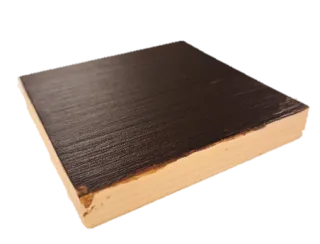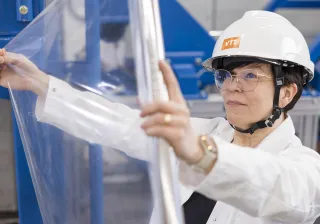Lignin is an abundant renewable aromatic compound and a promising alternative to fossil-based aromatics in many material applications. The SUSBINCO-project opened an opportunity for me to travel to the Basque country and learn about the development of polyurethane coatings.
Lignin is a complex aromatic polymer and one of the three main components in plant cell walls. While it is typically a side-product of biorefineries, lignin still lacks a large-scale utilisation. Same as plants come in many forms and sizes, so does lignin. The properties of the lignin depend on the plant source, isolation technique and processing history. Different types of lignins are suitable for different kinds of applications. However, finding the correct type of lignin for a specific application can be challenging. One reason for this is that the complex structure of lignin is challenging to analyse, and several different methods are needed to characterise different aspects of the lignin polymer.
The SUSBINCO-project aims to develop bio-based binder and coating materials which can potentially be used for barriers in packaging, paints, adhesives, sealants and abrasives. In the project, one specific task is to develop a water-resistant coating for wood that contains a high content of bio-based components. Specifically, the aim is to compare the performance of different lignins in coatings and understand which lignin characteristics contribute to the performance in the coatings. The lignins used in the project come from different botanical origin (softwood, hardwood and agricultural residues) and from different biorefineries or processes.
Research visit to Tecnalia to learn about polyurethanes
Tecnalia is the largest applied research and technology development centre in Spain with several locations across Spain. I visited the research centre located near Azpeitia, a beautiful small town close to San Sebastian with great opportunities for walks in the mountains.
Polyurethanes are an interesting material due to their versatility and durability: they have a wide range of applications from coatings to rigid or soft foams. A polyurethane is formed when a diisocyanate and a polyol react together to form a film of foam. Depending on the properties of both components and additives in the reactions, different products can be produced.
Polyurethanes are traditionally made from fossil resources and the starting materials are toxic, however, development on biobased polyols as well as isocyanates is ongoing.

Harnessing lignin as a renewable component in wood coatings
Lignin contains a high amount of hydroxyl groups and is therefore a polyol and an interesting candidate as a renewable raw material in polyurethanes. However, depending on the lignin structure the reactivity can vary. To increase lignin reactivity, it can be for example modified or fractionated.

During the two-week visit to Tecnalia I had one lignin from the project with me to learn about preparing polyurethanes. To increase reactivity, the lignin was modified in two ways and an unmodified lignin was used as a reference. During the course of the two weeks and with the excellent guidance of the people at Tecnalia, I was able to get an understanding on how polyurethane coatings are prepared, from designing experiments to applying the coating on different materials. Preliminary testing on water resistance were encouraging for further development and I am eager to continue the development of lignin-based polyurethane coatings with the remaining lignins at VTT.
The most memorable part of the visit was the hospitable people at Tecnalia who made me feel part of the team from day one - I am looking forward to working with them again in the future.
SUSBINCO is funded by Bio&Circular Finland program of Business Finland.
More information: https://www.abo.fi/fi/projekti/sustainable-binders-and-coatings/






